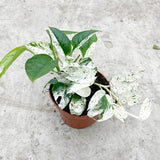Sold Out
15 - 20cm Tradescantia Brightness Houseplant 12cm Pot
Tradescantia 'Brightness', a cultivar of the Tradescantia family, is appreciated for its vibrant foliage and ease of care. Known for its striking colours and trailing growth, it's a popular choice for indoor gardens. Here's a detailed care guide for Tradescantia 'Brightness':
Description
- Appearance: Tradescantia 'Brightness' boasts pointed, lance-shaped leaves that are typically a deep green, often with bright purple or pink undersides. The plant's stems can also exhibit these vivid colours, adding to its ornamental appeal.
- Growth Pattern: It exhibits a fast-growing, trailing habit, making it ideal for hanging baskets or as a cascading plant on shelves.
Care Guide
-
Light Requirements:
- Prefers bright, indirect light to maintain its vibrant foliage color. Direct sunlight can cause the colors to fade or leaves to burn, while too little light can lead to leggy growth.
- East or west-facing windows are usually best, offering sufficient light without the harshness of direct midday sun.
-
Watering:
- Water when the top inch of soil feels dry to the touch. Tradescantia 'Brightness' likes consistent moisture but is prone to root rot if over-watered.
- Less frequent watering is needed in the winter months.
-
Humidity and Temperature:
- Enjoys a moderate to high humidity environment. Misting the leaves or using a humidifier can be beneficial.
- Thrives in temperatures between 15°C and 26°C. Avoid exposure to temperatures below 10°C and protect from drafts.
-
Soil and Fertilisation:
- A well-draining potting mix is suitable, such as a blend of standard houseplant soil with perlite or orchid bark.
- Fertilize every month during the growing season with a balanced, water-soluble fertilizer. Reduce feeding in autumn and winter.
-
Pruning and Repotting:
- Regular pruning helps maintain a bushy, full appearance and stimulates new growth. Trim back leggy stems as needed.
- Repot every 1-2 years when the plant becomes root-bound, using a pot only slightly larger than the current one.
-
Pest and Disease Management:
- Look out for pests like spider mites and aphids. Treat any infestations promptly with insecticidal soap or neem oil.
- Ensure good air circulation and avoid over-watering to prevent fungal diseases.
-
Propagation:
- Tradescantia 'Brightness' can be easily propagated through stem cuttings. Place cuttings in water or soil, and they will root quickly.
Additional Tips
- Light Exposure: If the plant's colors begin to fade, this may indicate a need for more light.
- Water Quality: Be mindful of water quality; hard water or water with high chlorine content can be harmful.
- Toxicity: Like many Tradescantias, this plant is mildly toxic if ingested, so keep it out of reach of pets and children.
Tradescantia 'Brightness' is a robust and adaptable plant, suitable for both novice and experienced gardeners. With its easy propagation and vivid colors, it can be a delightful addition to any indoor plant collection, bringing a splash of color and life to your space.
Check out our YouTube video to see exactly how we pack for safe delivery.
- Plants are supplied in plastic nursery pots unless stated in the product title.
- Plants are not for consumption unless stated as edible.
- Plant heights can fluctuate +/- 10%.
- Our plants are kept at our tropical nursery in Yorkshire where we maintain an average temperature of 18c.


































